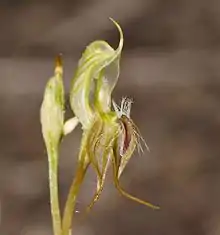Pterostylis setifera
Pterostylis setifera, commonly known as the bristly rustyhood[2] or sikh's whiskers,[3] is a plant in the orchid family Orchidaceae and is endemic to south-eastern Australia. It has a rosette of leaves and four to ten translucent white, green and brown flowers which have an insect-like labellum with long, bristly hairs.
| Bristly rustyhood | |
|---|---|
 | |
| Pterostylis setifera growing near Rushworth | |
| Scientific classification | |
| Kingdom: | Plantae |
| Clade: | Tracheophytes |
| Clade: | Angiosperms |
| Clade: | Monocots |
| Order: | Asparagales |
| Family: | Orchidaceae |
| Subfamily: | Orchidoideae |
| Tribe: | Cranichideae |
| Genus: | Pterostylis |
| Species: | P. setifera |
| Binomial name | |
| Pterostylis setifera | |
| Synonyms[1] | |
|
Oligochaetochilus setifer (M.A.Clem., Matthias & D.L.Jones) Szlach. | |
Description
Pterostylis setifera, is a terrestrial, perennial, deciduous, herb with an underground tuber. It has a rosette of between five and ten egg-shaped leaves at the base of the flowering spike, each leaf 20–40 mm (0.8–2 in) long and 6–12 mm (0.2–0.5 in) wide. Between two and ten transparent white flowers with green and light brown markings and about 18 mm (0.7 in) long are borne on a flowering spike 150–300 mm (6–10 in) tall. Five to eight stem leaves are wrapped around the flowering spike. The dorsal sepal and petals form a hood over the column with the dorsal sepal having an upturned point about 5–6 mm (0.20–0.24 in) long. The lateral sepals turn downwards, joined to each other for about half their length and are much wider than the hood. They have thread-like tips 7–10 mm (0.3–0.4 in) long and curve forwards and away from each other. The labellum is lance-shaped, 4–5 mm (0.16–0.20 in) long and about 2 mm (0.08 in) wide. There are 10 to 15 bristles up to 5 mm (0.2 in) long on each side of the labellum and many short bristles on the "head" end. Flowering occurs from September to November.[2][3][4][5][6]
Taxonomy and naming
Pterostylis setifera was first formally described in 1985 by Mark Clements, I.G. Matthias and David Jones from a specimen collected in the Ingalba Nature Reserve in Temora. The description was published in the Kew Bulletin.[1] The specific epithet (setifera) is a Latin word meaning "bearing bristles".[7]:67
Distribution and habitat
The bristly rustyhood grows in a variety of habitata including among rocks and in mallee vegetation. It occurs south from Narrabri in New South Wales and in scattered populations between Wedderburn and Rushworth in Victoria. It is only found the Murray botanical region in South Australia and is rare in both Victoria and South Australia.[2][3][4][5]
References
- "Pterostylis setifera". APNI. Retrieved 28 May 2017.
- Jones, David L. (2006). A complete guide to native orchids of Australia including the island territories. Frenchs Forest, N.S.W.: New Holland. p. 333. ISBN 978-1877069123.
- Jones, David L. "Pterostylis setifera". Royal Botanic Garden Sydney: plantnet. Retrieved 28 May 2017.
- Jeanes, Jeff. "Pterostylis setifera". Royal Botanic Gardens Victoria: vicflora. Retrieved 28 May 2017.
- "Pterostylis setifera". State Herbarium of South Australia: eflora SA. Retrieved 28 May 2017.
- Clements, Mark A.; Matthias, I.G.; Jones, David L. (1985). "A new species of Pterostylis (Orchidaceae) from southeastern Australia". Kew Bulletin. 40 (1): 77–80. doi:10.2307/4108475. JSTOR 4108475.
- Brown, Roland Wilbur (1956). The Composition of Scientific Words. Washington, D.C.: Smithsonian Institution Press. p. 392.